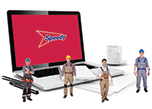
Top Tips to Stay Safe On-Site in Winter
The construction industry doesn’t stop when the winter months (and the weather which comes with them) arrive. From rain and snow to frosty temperatures and the risk of ice, working on-site in winter can increase the risk of hazards for construction workers.
Before the weather really takes a turn for the worst, you need to have a plan in place on how to be one step ahead. Remember that winter officially lasts until March, but some poorer weather conditions are starting to stick around for increasingly longer.
Most official guidance from the HSE focuses on warmer weather and heatwaves, but the negative effects of the cold begin when the outdoor temperature reaches between just 4-8°C, making winter just as dangerous to health.
How to improve safety on site in winter
1. Take time to clear hazards
Firstly, before any work can even take place, you need to clear the area of any obvious hazards. From removing snow and ice from walkways to checking for downed power lines or trees, the area needs to be safe and clear.
2. Make paths and roads safe
Put down salt on paths and ensure there are signs up to warn workers of potential black ice. Workers should be careful with footing and move slower to decrease the risk of slips and falls. You may need to adapt paths or cordon off areas which are particularly dangerous until later in the day when they’re safe.
The use of pedestrian barriers can define paths, guaranteeing people stick to the actual gritted areas.
As well as walkways, any vehicle paths will need to be cleared too. Hire Maxi Tracks for use on any softer surfaces, to give heavy-duty vehicles maximum support and mud suppression.
3. Boost your lighting
In summer, you may be able to get away with having no lighting during working hours thanks to the natural sunlight. In winter, no such luxury exists.
The sun can rise after 8 am and set before 4 pm, and depending on what you’re working on, the day may start and end long before this. Artificial lighting is required for safety if natural light isn’t sufficient.
All areas should be well lit, from walkways to work areas. Lighting can also help increase security; longer dark periods mean the risk of break-ins and vandalism can increase in winter.
4. Test your tools
Cold weather can mean tools struggle to get going. It can also cause wires and leads to start becoming brittle. All tools and equipment needs to be checked thoroughly before use, and you need to test everything before launching into a job.
5. Provide shelter and warmth
All workers need a break, but in winter weather, an outdoor break area won’t do. Workers use up more energy in the cold, as their body is also trying to keep warm. A heated trailer or other indoor areas should be supplied, as well as warm drinks and somewhere to warm food.
Encourage workers to take frequent breaks to stay warm. Check everyone for signs of hypothermia and fatigue in their downtime.
If using portable heaters, the room needs to be well ventilated, and you should have carbon monoxide sensors in place.
6. Supply winter PPE
Personal Protection Equipment and safety gear in winter will be slightly different to what is required in summer. High-vis clothing should remain in place, but you may need to swap out hard hats for ones which have a lining to help retain heat and keep workers warm.
Gloves which still allow dexterity are required, and they should be worn at all times. If somebody touches cold metal with a bare hand, frostbite can occur immediately. Waterproof boots with good grip, and anti-fog spray on any safety glasses, are also needed.
Encourage workers to wear thick socks, and layer up thermal clothing under workwear. Have a spare supply of work clothing on site for any workers who get wet in a rain shower and need to change.
Safety equipment, such as fall arrest systems, should be adjusted to fit over bulkier clothing.
7. Keep an eye on the weather forecast
You need to put your workers first. Plan for when the safety plan needs to be implemented and also bear in mind that the weather could become too dangerous to work in. Snow and blizzards can decrease visibility and underfoot safety on-site, and freezing temperatures can be a health hazard.
If it gets extremely cold, the risk of hypothermia and frostbite increases, especially if your workers use up their stored energy to do their job. Decide on the lowest possible working temperature, and when it drops to this point, send everybody home.
Your workers need to get home after their day, too, so also consider how difficult the change in weather could make this. Potential hazards increase during winter driving.
- 2024
- 2023
- December 2023 (13)
- November 2023 (10)
- October 2023 (6)
- September 2023 (10)
- August 2023 (20)
- July 2023 (21)
- June 2023 (17)
- May 2023 (17)
- April 2023 (17)
- March 2023 (14)
- February 2023 (15)
- January 2023 (7)
- 2022
- December 2022 (6)
- November 2022 (12)
- October 2022 (24)
- September 2022 (14)
- August 2022 (12)
- July 2022 (15)
- June 2022 (18)
- May 2022 (14)
- April 2022 (9)
- March 2022 (5)
- February 2022 (5)
- January 2022 (2)
- 2021
- December 2021 (7)
- November 2021 (10)
- October 2021 (1)
- September 2021 (1)
- August 2021 (3)
- July 2021 (3)
- June 2021 (4)
- May 2021 (1)
- April 2021 (1)
- March 2021 (2)
- February 2021 (1)
- January 2021 (1)
- 2020
- 2019
- 2017
- 2016
- 2014
- 2013
- 2012
- 2011


